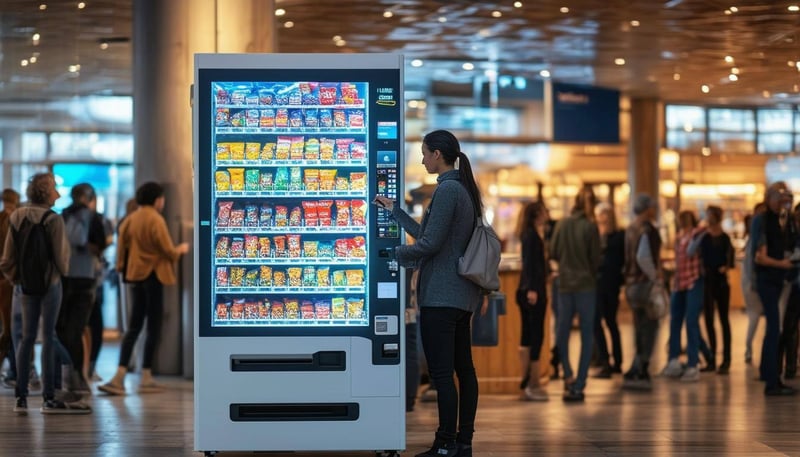The Future of Self-Service Machine Operations: Are You Ready for What’s Coming?
 By
Katherine Perez
·
3 minute read
By
Katherine Perez
·
3 minute read
Self-service machines have become an integral part of daily life, from ATMs and kiosks to digital signage and vending machines. Businesses rely on these systems to operate seamlessly, providing customers with fast, efficient, and reliable service. But as we move into 2025, one thing is clear: the landscape of self-service technology is rapidly evolving, and those who don’t adapt risk falling behind.
What’s driving this shift? It’s a combination of factors—advancements in AI and IoT, the rise of automation, and increasing expectations for real-time, personalized experiences. But with these innovations comes a crucial challenge that too many businesses overlook: the importance of continuous connectivity and power management.
A vending machine that can predict product demand based on foot traffic data is great—until it goes offline. An AI-powered digital sign that dynamically updates content based on audience demographics is a game-changer—unless it suddenly stops displaying anything at all. And a banking kiosk that offers biometric authentication for seamless transactions is cutting-edge—until customers walk away frustrated because it’s “temporarily unavailable.”
We’re in an era where smarter machines require smarter infrastructure, and that means ensuring uptime, reducing downtime, and having the right tools in place to prevent service interruptions before they happen.

Smart Machines Are Getting Smarter—But Are They More Reliable?
AI and IoT are transforming self-service machines, making them more intelligent, responsive, and personalized. Digital signage networks can adjust advertisements in real time based on audience demographics, ATMs can diagnose potential hardware failures before they happen, and vending machines can restock themselves based on predictive analytics.
But all of this intelligence is only as good as the machine’s ability to stay online. One network failure, power fluctuation, or system freeze, and suddenly all those high-tech capabilities become useless.
What does this mean for businesses? It means that reliability isn’t just about hardware anymore—it’s about connectivity, proactive monitoring, and remote intervention.
For example, a retail store investing heavily in interactive kiosks must ensure these devices are always operational to provide customers with a seamless experience. If a kiosk loses network connectivity, the entire user experience collapses. Similarly, in transportation hubs, real-time digital signage guiding passengers through complex terminals is only effective if it remains consistently online and up to date.
This is where remote power management solutions like Switch Always On become essential—not as an afterthought but as a foundational component of next-gen self-service infrastructure.
The Hidden Costs of Downtime: More Than Just a Reboot
When a self-service machine goes down, the immediate impact is obvious—frustrated customers, missed transactions, and lost revenue. But the long-term consequences can be far worse.
Downtime erodes trust. It damages brand reputation. It increases operational costs due to the need for constant manual intervention, technician dispatches, and unexpected maintenance.
Let’s talk about ATMs for a moment. They’re everywhere, and they’re expected to just work. But when they don’t, the customer experience suffers. Studies show that nearly 60% of customers will abandon an ATM after just one failed attempt—often choosing a competitor instead. And for ATM operators, frequent truck rolls to manually reboot or service machines add up fast, with each visit costing anywhere from $150 to $500 per trip.
Similarly, in digital signage, downtime means more than just a blank screen—it means lost advertising revenue, unmet service level agreements (SLAs), and reduced customer engagement. Every second counts when screens are meant to drive purchases, inform commuters, or enhance brand visibility.
So, what’s the solution? Proactive monitoring, real-time alerts, and remote reboot capabilities. Solutions like Switch Always On Hybrid provide an optional cellular backup, ensuring that even if the main network connection drops, the machine can still send real-time heartbeat alerts. Instead of learning about the problem from an unhappy customer, operators can respond before it even escalates.
Why Basic Remote Power Switches Don’t Cut It Anymore
Many businesses still rely on traditional remote power switches like WattBox and Miniboot, assuming these solutions are enough to keep their machines running smoothly. While these products offer basic reboot functionality, they lack the intelligence required to proactively manage power and connectivity at scale.
Here’s how Switch Always On stands out:
-
Optional Cellular Backup for Critical Alerts
If a machine’s primary internet fails, Switch Always On keeps the heartbeat alive via 4G backup connectivity, ensuring operators receive real-time alerts instead of discovering an outage hours later. -
Independent Battery Backup for Networking Equipment
When power is lost at a location, the backup battery keeps essential networking devices—such as cellular routers—powered on, ensuring alerts and notifications continue. It also allows Switch Always On to trigger an auto-reboot, attempting to restore power remotely before a technician is dispatched. -
Remote Reboots & Power Cycling
Instead of sending a technician to physically reset a machine, operators can reboot individual components remotely—reducing costly service calls and minimizing downtime. -
Cloud-Based Monitoring & Control
Operators can manage power, schedule reboots, and troubleshoot issues from anywhere via a secure cloud dashboard, ensuring machines remain operational even when no one is on-site.
In short, it’s not just about powering on and off—it’s about predictability, prevention, and complete control.
The Future of Self-Service is Connected. Are You Ready?
The industry is changing fast. AI, automation, and real-time data are shaping the next generation of self-service machines. But with every advancement, the need for better connectivity and smarter power management becomes even more critical.
At Switch Always On, we believe that true innovation isn’t just about what a machine can do—it’s about ensuring it can do it consistently. Whether it’s ATMs, kiosks, vending machines, or digital signage, businesses need a solution that keeps operations running, minimizes truck rolls, and enhances uptime efficiency.
How is your business preparing for 2025? Let’s talk about how you can future-proof your operations.
